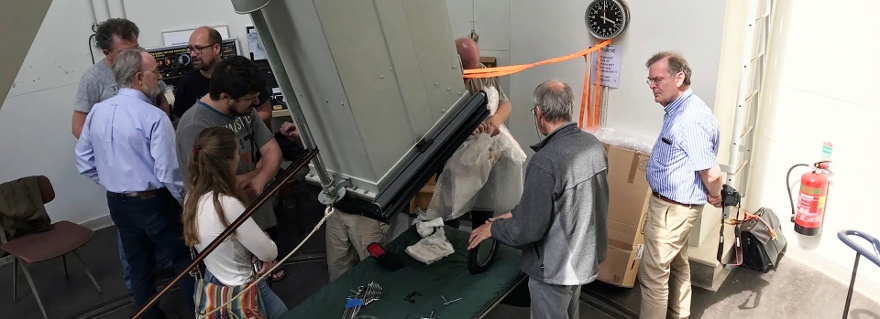
A 120 year-old Telescope Gets a Makeover
For the first time more than half century, one of oldest telescopes at Leiden Observatory is getting a major improvement.
Last Wednesday, the lenses of Leiden Observatory’s Astrograph Telescope were removed and shipped off to the Dutch Navy to be cleaned and restored. This is the first time in recent memory that this kind of maintenance is carried. Not only will it greatly benefit the optical quality of the telescope, but it also serves as a statement that Leiden University values its historic scientific instruments.
'Something between the Lenses'
Willem-Jan Trijssenaar, amateur astronomer and board member of one of Leiden’s astronomical societies, the WLS, explains: “[The lenses were removed] because we found that they had become pretty dirty, which caused problems while observing. […] We thought that the tarnish we saw may be limescale or that someone had touched the lenses. Now it looks like there is something between the two lenses. What it is exactly, we don’t know yet.”
When asked how often the lenses are cleaned, Willem-Jan laughingly replied: “I think this is the first time”.
Long Exposures
Astrophotography was a quickly developing technique of mapping the night sky at the end of the 19th century. The newly acquired ability to make long exposure images of the night sky it enabled astronomers to observe stars that were previously invisible to the naked eye The Astrograph Telescope in Leiden was built in 1897 at the request of Dutch astronomer H.G. Van de Sande Bakhuyzen for the accurate measurement distance to nearby stars. The telescope has been used for research for more than half a century. Nowadays the telescope is used by very enthusiastic citizen-scientists (amateur astronomers) and astronomy students, as well as being used for public tours.

Cleaning in a Laboratory
Most of the day-to-day maintenance of the historic telescopes is done by the Amateur Astronomical Society the WLS. However, due to the complexity of this project, this time the task is carried out by Het Marinebedrijf, the research & development division of the Dutch Navy with strong historical ties to the Leiden Observatory.
Back in the 19th century, when Leiden’s astronomers still spent their observing nights on the roof of the academy building, astronomer Frederik Kaiser (later the initiator of the construction of the current Leiden Observatory building) was appointed Verificateur van ’s Rijks Zee-Instrumenten. He was tasked with advising the minister of the Dutch Navy and approving navigation instruments for use at sea. Later this process of advising and approving transformed into a nautical company with close ties to the navy. Years later, after multiple fusions and relocations, what started as a small business on the roof of the Academy Building in Leiden, is now a sizeable division of the Dutch Navy, Het Marinebedrijf. One of the early examples of spin offs from Leiden University.
Over the course of the following weeks, the technicians from Het Marinebedrijf will thoroughly clean the Astrograph’s lenses at their labs. Dr. Jan Lub, astronomer from Leiden Observatory, was very enthusiastic about the development. “[We] are very happy that the people from WLS are so enthusiastic about using our telescopes. The telescopes are not longer in use for astronomical research, but they still carry decades-long of relevant scientific history and are important instruments for amateur astronomy and public outreach.
Telescope back in Action
According to Willem-Jan Trijssenaar, the telescope will be back in action halfway October, just before the Leiden Observatory Open Day, which will take place on the 29th of October. Let’s hope by then the skies will be as clear as newly polished lenses.
Meanwhile, the Leiden Observatory is still open for visits three times a week, on Wednesdays and in the weekends. Private tours can also still be booked to visit the other historic telescopes available in the building.
